On a warm spring day, there is nothing better than a simple salad for lunch that you have just picked and put together in the garden. Eating outside somehow makes everything taste better.
I did this recently with my friend Sinead at our community garden as a practical way of helping her identify weeds and flowers she could add to her salads. Using weeds and flowers will make salad greens go further, will produce a salad with more eye appeal, and will deliver plant diversity to your table. Even if you need to buy the basic salad green, additional vital minerals and micro-nutrients (as well as flavours and textures) can be added by collecting weeds and garden flowers to add to your salad.
I selected curly endive as my base salad green but you can also use lettuce or baby spinach. In Auckland we can have lettuce ready at this time of the year but in the south, in early spring, I would rely on other not so well known salad greens that can take cooler growing conditions like curly endive, miner's lettuce or corn salad.
Miner's lettuce Claytonia perfoliata is also called winter purslane as the leaves have the same slightly succulent texture as purslane. Miners lettuce got it's name because early gold miners would plant it wherever they set up camp. Mineers lettuce would provide them with much needed vitamin C at a time of year when there were little other fresh greens available. It's a plant that's wild at heart, grows quickly and will easily self sow. While not a perennial, as such, it is a good addition to a perennial kitchen garden because if allowed to seed, it will pop up every winter.
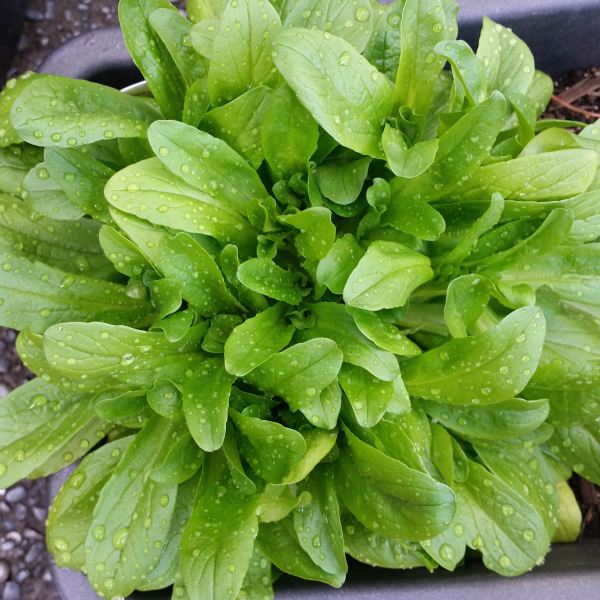
- Kings Seeds have the seeds of Corn Salad Verte de Cambrai which is a traditional French variety. In France corn salad is one of most popular salad greens. The variety I am growing above is also from Kings Seeds but is a larger leafed variety called Dutch Large Seeded 3190 in the organic seed range.
Corn salad Valerianella locusta (also called lambs lettuce or Mâche) is another winter early spring salad green that is mild flavoured like lettuce. It forms a small rosette, and you can harvest the whole plant or simply pick off leaves allowing more to grow. This year I have grown them really well in a pot, doing better than those in the garden, probably because they don't have to compete with larger plants so it's a good option for apartment dwellers.
Once the green salad base of curly endive and corn salad has been gathered, we collect and identify weed additions for the salad; chickweed, creeping speedwell, nipplewort and dead nettle. These spring weeds I have identified in my previous posting Mahuru Goddess of Spring Weed Salads in September.
I then collected a number of spring flowers to add colour and extra flavour to our salad. Where to start when considering what flowers to use?
It's important to correctly identify anything you eat, but you are pretty safe to use any vegetable plant that has gone to flower. Rocket goes to flower very quickly and the peppery flowers are good to eat. Broccoli, kale, mustards and mizuna all produce little four leaved yellow flowers that can add colour and a mustardy flavour of varying degrees. In my garden plot I have pretty pink blooms of a radish that hadn't been harvested so we added these to our salad mix.
The other group that are usually pretty safe are herbs. The flowers often have a more intense flavour than the herb foliage.
Calendula officinalis is a herb I use in both salads and cooked dishes nearly year round. It's a great little flower to have growing in your garden. It's a perennial but is often treated as an annual and if let to seed will self sow readily. The flowers can be bright yellow or orange and have a yellow centre or a black centre. I pull off the petals to add a rich yellow to the green salad. Using Calendula petals does more than just add colour, there are nutritional and medicinal benefits for the digestive tract, liver and gall bladder.
Blue is an intense colour that is noticeable in a salad of green. The blue herb Borage, Borago officinalis , with its bright blue star shaped flowers is a real favourite of mine, as well as with the bees in the garden. It's supposed to be a good companion plant for legumes, strawberries and tomatoes although don't interplant as borage does get quite large and gangly as it gets older. It's best planted at the end of a row or in a corner near the plants you want it to companion. If transplanting get the seedlings into the ground when small as they don't easily move due to their taproot. Best to scatter some seeds in the area you want them to grow and if you let them seed then there will always be borage.
Borage is often used in ice blocks to decorate summer drinks. Borage has medicinal qualities and has been used since ancient times to dispel melancholy and to induce euphoria...and we can all do with that from time to time.
I noticed a rosemary flowering so picked a few of the blue blooms to add to our salad.
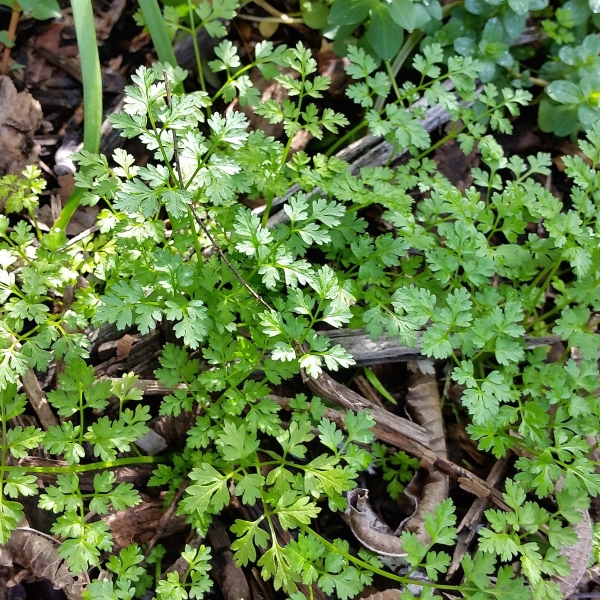
- Chervil, like coriander, will remain longer without going to seed if it is grown with the help of some shading from a taller crop. We've had trouble establishing it in our community garden because of the heat and dryness. We have found a safe place for it under the lemon verbena tree and hope it will self sow and spread.
We collected from the herb garden a few sprigs of my favourite salad herb, chervil. This delicate herb is a good one to get growing in your garden. It's in the same family as parsley but has a more delicate flavour with a faint taste of liquorice or aniseed. It has good digestive properties but its not always easy to grow. Chervil quickly runs to seed, especially if transplanted because of its tap root so it's best to sow seeds directly. Once it's found it's happy place, it will self sow.
When young the poisonous plant hemlock could be confused with chervil, but hemlock has purple spots on its stems and the best check is to crush the leaves and smell before picking - chervil smells of aniseed balls and hemlock of mouse pee.
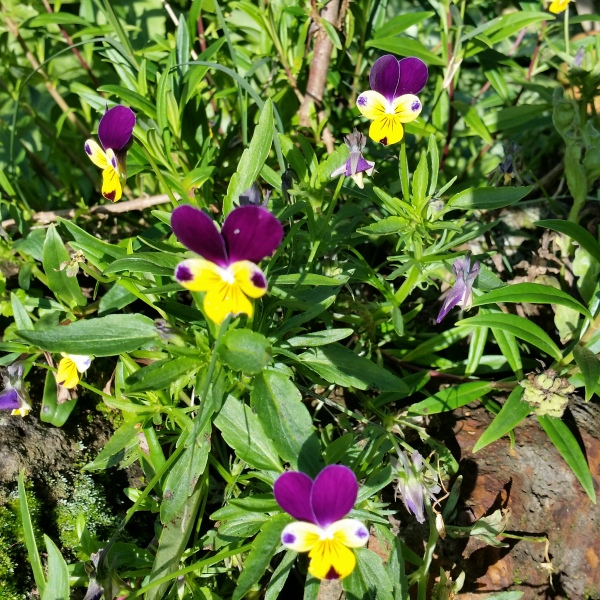
- "Each fertilised flower produces a seed capsule which opens by three valves to expel and disseminate numerous seeds. Small, white appendages to the seed, so-called elaiosomes, also aid distribution. Ants love these appendages, which are rich in fat, and drag the seeds to their nests. There they separate the nourishing appendage from the seed, which is then thrown out of the nest again". Dr Hauschka Skincare, Germany
Heartsease Viola tricolour is a wild flower herb that has been bred to create the pansies and violas in flower gardens. Heartsease is the bearer of a host of other common names: heart's delight, tickle-my-fancy, Jack-jump-up-and-kiss-me, come-and-cuddle-me, three faces in a hood, love-in-idleness and kiss-her-in-the-buttery, to name a few. All these old names indicate what this plant was traditionally used for - to ease complaints of the heart and as a love potion. The flowers were also made into a cordial to help children with coughs and to repair skin conditions.
I did find it difficult to establish from seed but it's growing really well scrambling over rocks at the front of my garden plot. It's really an annual but it's now in its second year and blooming it's heart out. I have noticed ants around these rocks so I'm hoping they will help to establish new heartsease.
The flowers are soft and of little flavour but they are a show stopper on the plate...and then there's that intriguing notion of it's love potion power.
Abutilon is in the mallow family with common names velvet leaf or Indian mallow and needs a subtropical or tropical climate. In southern regions an alternative could be day lilies Hemerocallis as they are also edible and have a similar taste to abutilon. Abutilon tastes even sweeter than a courgette or pumpkin flower. It's velvet soft texture makes this flower easy to eat.
Violet Viola odorata's sweet flower matches it's sweet perfume. They are particularly lovely placed on desserts but I also like them included in a salad. You can eat the leaves with two leaves having as much vitamin C as an orange. The flowers heated in sugar and water will extract a floral scented syrup to use in desserts.
Back at our garden table I processed my collection cutting up plant leaves into bite sized pieces, and discarding tough stems. I then tossed through the dressing I had brought in a container made from orange juice, lemon, oil and seasoning and cut up an orange to add a little sweetness to the salad. Last touch is to mix through the calendula petals and place the other flowers on top to create a pretty salad.
I came to the gardens with a good bread from a bakery made from spelt flour and Sinead contributed some cheese. We had enough food to share our lunch with three other community gardeners.
To make it a total garden experience I made a pot of fresh herbal tea with rosemary and lemon balm.
At lunch I was asked if forget-me-nots Myosotis scorpioides were edible. I didn't have the answer then but have since discovered they too are in the borage family, and yes the little blue flowers are edible.
You may not yet have borage growing, but I bet there will some forget-me-nots popping up in your garden this spring.

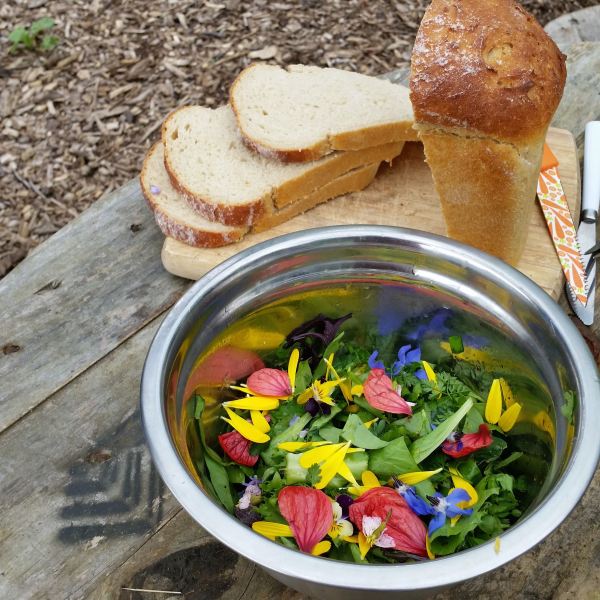
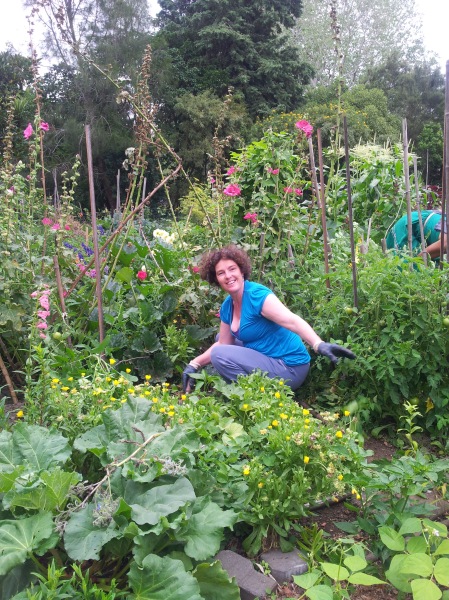


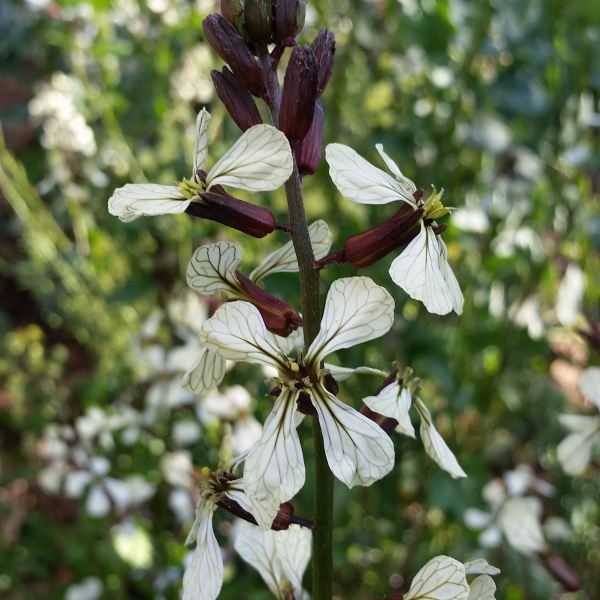

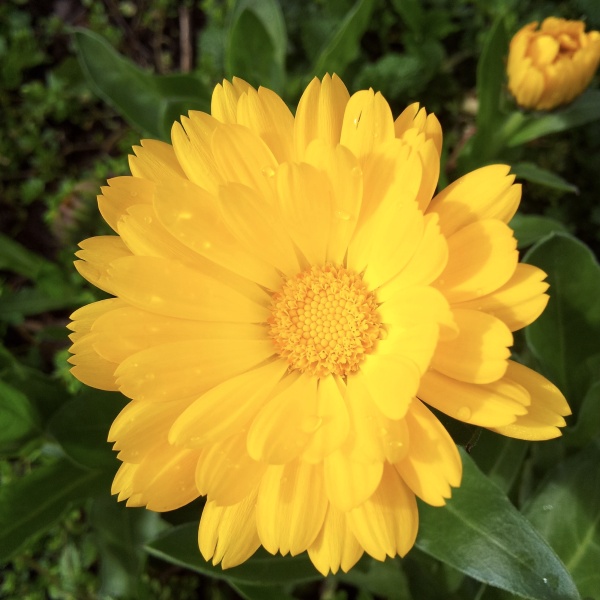
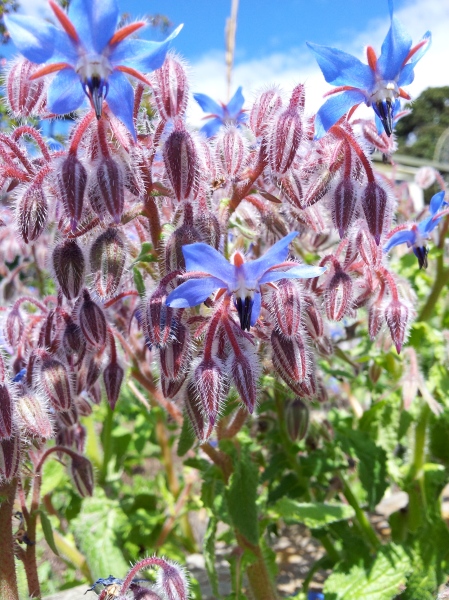
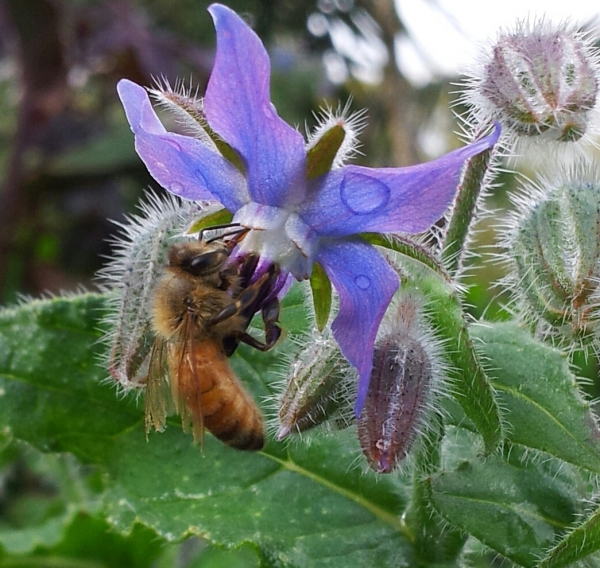
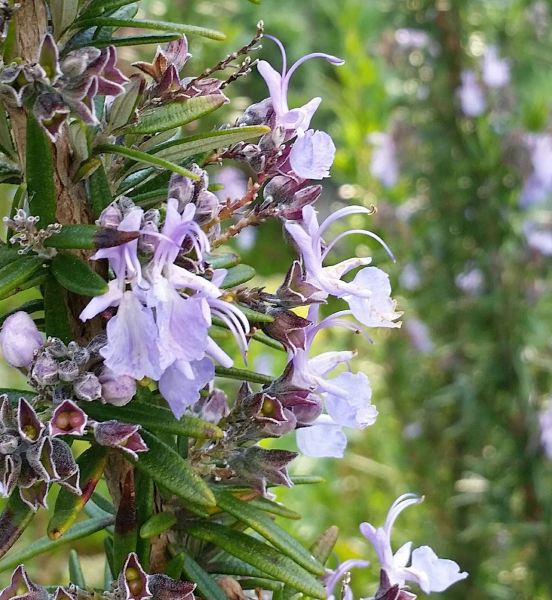
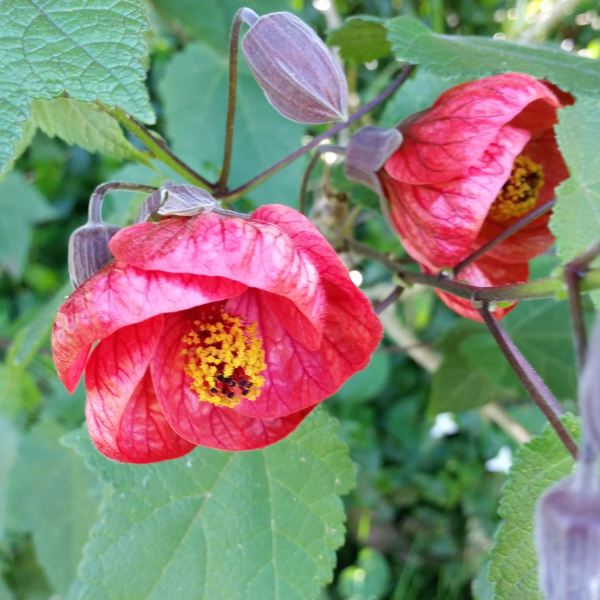
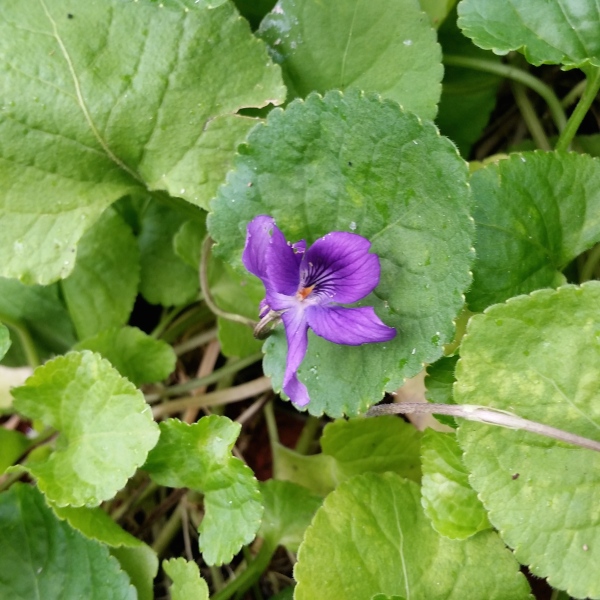
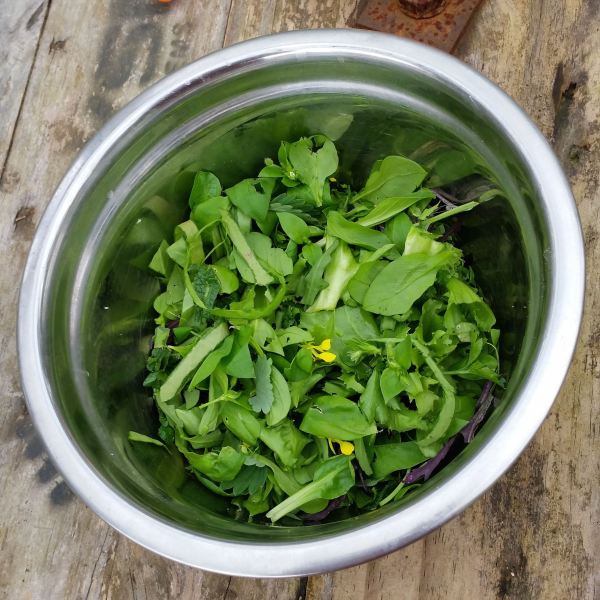
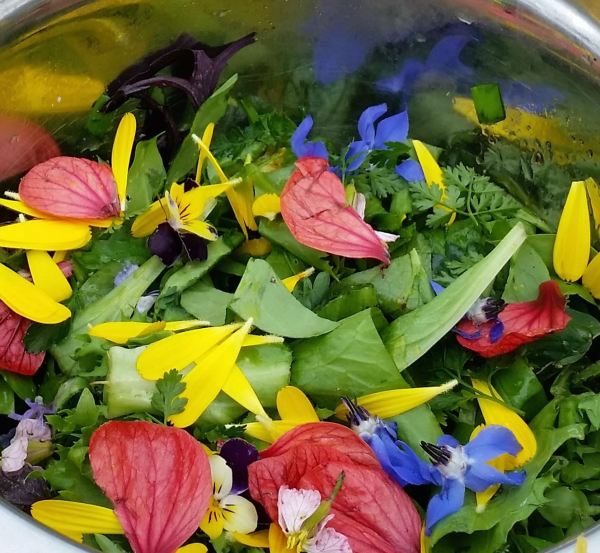


No comments:
Post a Comment
Would like to see your comments or share some of your favourite recipes.